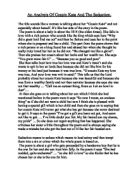In Christianity, Sookhoo is guilty of the sin of avarice or greed which is one of the seven deadly sins that signal total loss of faith. In the story, Mr Sookhoo is not a Christian but pretends to be one convincing Mr Archibald that he had "seen the light" in order to gain his approval for sending children with him on the carol singing mission. Mr Sookhoo's avarice leads to his eventual downfall when he is found out and captured at the end of the story. Sookhoo's avarice leads to a snowballing of unfortunate occurrences that upset the money-making plan that seemed to be going too well. All at once many characters appear in the story pushing, as it were, one more nail into Sookhoo's coffin. First, Mr Ali, who had previously paid Sookhoo to deliver some gravel for him, appears and exposes Sookhoo's failure to keep his end of the bargain. In addition, Mr Archibald, who started harbouring doubts about Mr Sookhoo when the latter's account of the carol singing successes did not correspond to what Mr Archibald was told by a young pupil called Horace, receives a visitor by the name of Mr Harris (who is a real philanthropist working in the charity field) who confirms to him that the deaf, dumb and blind institute does not exist. These revelations and findings raise tension in the story and drive the plotline towards its climax when Mr Sookhoo's love of money brings about his downfall and arrest.
At the end of the story, poetic justice is upheld as the aggressor and wrong doer is punished while the good are rewarded. "Mr Sookhoo" ends on the note that a blind love of money can only lead to negative consequences. The price that Sookhoo pays for being a slave to money and materialistic gain is no less than his freedom. Mr Sookhoo's metaphorical slavery (signaled by his servitude to anything that can lead to making money) at the beginning of the story becomes the cause of his physical incarceration, which is a form a slavery, at the end.
Although in the case of Mr Sookhoo, poetic justice is upheld as good is rewarded and evil is punished, the so-called "cliff-hanger" ending of "A Cat Within" where the reader is left to decide whether justice will be at all served, contrasts to the message of "Mr Sookhoo." In "A Cat Within," where the symbol of the cat acts as a reminder of a dark secret that comes back to haunt the un-named "Shopman" in the story, the love of money seems to have caused a series of crimes much weightier than those committed by Mr Sookhoo, but there is no indication that these crimes will be punished. In fact, one possible interpretation for the blurred ending of the story is that the Exorcist's own love of money will prompt him to eternally blackmail the Shopman in order to keep his crimes safely tucked away and hidden like the cat's head stuck in the metal urn. "A Cat Within" ends with the Exorcist withdrawing into his room but reminding the Shopman that he will request his pay later. This reminder could be read as a covert threat and a prelude to a life-long blackmail project the Exorcist hopes to embark on.
In "A Cat Within," both the Shopman and the Exorcist display their extreme attachment to money. On the one hand, the Shopman keeps his tenants in dire living conditions and sacrifices his own comfort by sleeping in the doorway to stop intruders from coming into his house. On the other hand, the Exorcist makes his living by giving the false impression that he is curing people from obsessions by demons and other supernatural evil beings. When the Exorcist is called upon to help with the assumed "evil spirit" wreaking havoc in the shop store, his world that places money at the top of the consideration list and the world of the Shopman, where money occupies the same place, meet. The Exorcist being adept at reading people like a book, manages to speculate accurately about the Shopman and the way he came to accumulate his wealth. It transpires that the Shopman killed a man and his widow before taking their land and money. However, unlike Mr Sookhoo, the Shopman remains free at the end with the cat, a symbol of his dark secret, roaming in the streets with a jug on its head. The symbolism of the cat slipping out of the store but with its head still caught inside the jug suggests that the Shopman’s secret is only half revealed.







